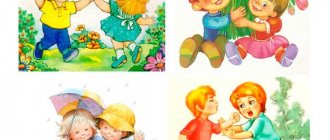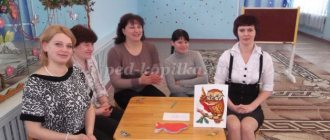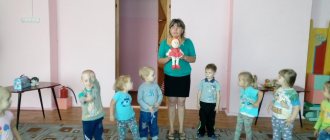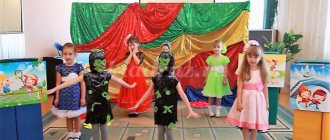Thematic week “Visiting a fairy tale.” Senior group
Topic of the week: “The fairy tale is a lie, but there is a hint in it!
A lesson for a good fellow” for children 5-6 years old Description : this material will be of interest to teachers of senior and preparatory groups, primary school teachers, and mothers of many children. Goal : expanding children's knowledge about Russian folk tales Tasks: - to reveal to children the concepts of “fairy tale”, “folk tale”; - learn to tell fairy tales, retell them by role; — introduce the artist-illustrator of fairy tales Viktor Mikhailovich Vasnetsov; - promote the development of artistry, emotionality, through playing the role of a hero; — cultivate a love for the native language through reading and knowledge of Russian folk tales; - to cultivate an emotional perception of the content of a fairy tale.
MONDAY
Conversation “The fairy tale begins from the beginning, is read to the end, and is not interrupted in the middle”
Goal: teaching the rules of listening to a fairy tale.
Objectives: - clarify and consolidate the understanding of “fairy tale” as a work and as a term; - promote active listening from start to finish without interrupting; - promote the development of logical thinking; - contribute to the development of respect for the narrator, the speaker. Role-playing game: “Book Hospital”
Purpose: teaching to take care of books.
Objectives: - learn to “fix” a “sick” book; — continue to teach how to use scissors correctly and carefully glue; — promote the development of creative abilities; - contribute to the education of accuracy and thrift. Creative activity:
Drawing: “Alyonushka by the Pond” based on the painting by Viktor Mikhailovich Vasnetsov Modeling: “Little Goat”
Theatrical activity:
acting out mini-scenes based on a fairy tale
D/i:
“Which fairy tale is the hero from?”, “Guess the hero”
Art reading:
“ Sister Alyonushka and brother Ivanushka" (magical fairy tale) Reproduction of the painting: "Alyonushka" by Vasnetsov
Work with parents:
"My favorite book of fairy tales": children bring books from home and a mini-library or mini-store is compiled.
TUESDAY Conversation: “Folk tale - magical, about animals, everyday”
Goal: expanding the understanding of a folk tale.
Objectives: - give the concept of “folk”; - to develop knowledge about the division of fairy tales into three types: magical, about animals, everyday; — promote the development of children’s speech activity; — to promote interest in Russian folk art and pride in one’s people. Excursion to the library. Role-playing game “In the Library”
Goal: to introduce children to visiting the library Objectives: - to teach them to play the role of a librarian and reader, to conduct a competent dialogue;
- promote the development of artistry and creative activity; — to promote interest in the library as a home where books live. Creative activity:
Drawing: based on the fairy tale “Crane and Heron” Modeling: “Plate and Jug” Application: “Jug Decoration”
Theatrical activity:
acting out mini-scenes based on the fairy tale Goal: development of artistic abilities.
D/i:
“Describe the hero”
Fiction reading:
“The Crane and the Heron” (a fairy tale about animals) Examination of illustrations for the fairy tale.
Conversation: “Book illustration” Purpose: to familiarize yourself with the concept of “illustration” Work with parents:
please take your children to a bookstore.
WEDNESDAY Conversation “Heroes of fairy tales - what are they?”
Goal: expanding children's knowledge about the character of heroes.
Objectives: - learn to name the distinctive features of heroes, naming positive and negative qualities; - learn to describe actions and explain their meaning; – promote speech development and expansion of children’s vocabulary; - promote the development of correct behavior, a sense of compassion for the weak, and a desire to help. Role-playing game: “Bookstore”
Goal: developing children’s social experience through play activities.
Objectives: - teach how to properly conduct dialogue in a store; - learn to play the roles of seller and buyer; — promote the development of creative abilities; — promote a culture of behavior in the store. Creative activity:
Drawing: depiction of negative and positive characters Modeling: “Pot of Porridge” Application: “Golden Scallop Cockerel”
Theatrical activity:
acting out mini-scenes based on a fairy tale Goal: development of artistic abilities.
D/i:
printed board game “Tale by Tale”, “Which hero does the object belong to?”
Literary reading:
“Porridge from an Axe” (everyday fairy tale), “Flourish Hare”, “Cowardly Hare” and “Brave Hare”, etc.
THURSDAY Conversation “Vasnetsov - artist-illustrator of fairy tales”
Goal: introducing children to illustrators Tasks: - repeat the concept of “illustration”, “artist-illustrator”;
- give the concept of “reproduction”, “picture”; - learn to look at a picture and describe it; — promote the development of children’s speech activity; - promote interest in artistic creativity. Role-playing game: at the request of the children
Goal: development of children's creative activity
Creative activity:
Drawing: based on any of the selected fairy tales Modeling: based on any of the selected fairy tales Application: based on any of the selected fairy tales
Theatrical activity:
acting out mini-scenes based on the fairy tale Goal: development creative and artistic abilities of children.
Fiction reading to choose from:
“The Snow Maiden”, “Ivan Tsarevich and the Gray Wolf”, “Underground Kingdoms”.
Conversation “What do fairy tales teach?”
Goal: generalization and consolidation of acquired knowledge from fairy tales. Objectives: - learn to generalize acquired knowledge;
- promote the development of memory and observation; — to promote the cultivation of love for Russian folk art. Role-playing game: at the request of the children
Goal: development of children's creative activity
Creative activity:
Drawing: plot from a fairy tale to choose from.
Modeling: “Frog” Application: “Swans in the Pond” Theatrical activity:
acting out mini-scenes based on a fairy tale Goal: development of children’s creative and artistic abilities.
D/i:
“Guess the riddle”, assemble a picture from puzzles.
Fiction:
“The Frog Princess” Consideration of Vasnetsov’s reproduction. Throughout preschool age, children love to listen to fairy tales, retell them and write their own. Fairy tales in general contribute to the development of fantasy, imagination, creative thinking, make the child’s world magical, teach kindness and responsiveness, compassion and understanding. Read fairy tales more often! I hope my material will be interesting and useful to all those who work with children.
We recommend watching:
Thematic day in the preparatory group on the topic “Insects” Notes for a mathematics lesson in the senior group “Kolobok’s Journey” Notes on speech development in the senior group “Poultry” Thematic week “Wintering birds” in kindergarten. Second early age group
Similar articles:
Cultivating cognitive interest in social reality in children of senior preschool age
Conversation for preschool children “What is a fairy tale?”
Conversation “What is a fairy tale?”
Goal: to generalize and systematize children’s knowledge about fairy tales as a genre of literature.
Didactic objectives: expand children's understanding of the fairy tale genre; teach children to compose a fairy tale plot on their own; consolidate knowledge about fairy-tale characters and magical objects.
Developmental tasks: develop children's thinking and speech; stimulate the development of verbal and logical thinking; develop children's attention.
In a certain kingdom, in a certain state... Guys, what begins with such words? (Fairy tale) That's right, a fairy tale. How else can a fairy tale begin? (Once upon a time, beyond distant lands, in the distant kingdom). But is it only by this beginning that we recognize a fairy tale? Listen to what I have to say. In a certain kingdom, in a certain state, there lived a cat. He loved to eat sour cream and sleep. End. This is a fairytale? (No) Why? (Children's answers) Well done, you've picked up a lot of signs of a fairy tale, let's repeat them again.
1. The most important sign is that in fairy tales something happens that cannot happen in reality. For example, in fairy tales animals can talk. And what else?
The game “It happens - it doesn’t happen” (the teacher voices a thing or phenomenon, and the children clap or stomp if this happens or does not happen in reality, respectively).
2. A fairy tale has a beginning, middle and end.
What happens at the beginning? That's right, at the beginning we are introduced to the heroes of the fairy tale and where they live.
In the middle of the tale, the main events take place: the hero tries to achieve his goal, despite all the difficulties.
At the end of the tale, the hero receives what he wants and a reward for his courage, intelligence and kindness.
Do you remember who often helps heroes achieve their goals?
3. In fairy tales there are special heroes who appear from fairy tale to fairy tale. Which?
Physical school
4. In fairy tales, the hero moves towards his goal, but villains interfere with him or an obstacle simply gets in the way. Let's remember how and to whom the villains interfered in different fairy tales.
5. Fairy tales contain magic and special magical objects. For example, here’s a ball (shows a ball of woolen thread). Whose is it? Shall we play with him?
D/i “Magic Ball” (Children pass the ball to each other, naming some fairy-tale object).
6. And the most important rule of the fairy tale: good always triumphs over evil. Why is this so, and not vice versa?
Well done guys, they were able to remember all the features of the fairy tale. Now let's try to come up with our own fairy tale. So, Far, far away, beyond the blue seas, behind the high mountains, there lived...
Source
The benefits of fairy tales
This literary genre is very interesting and important. Even in the work of the great poet A.S. Pushkin, they played an important role. “What a delight these fairy tales are!” - wrote A.S. Pushkin. And he wrote the first poem in this genre - “Ruslan and Lyudmila”, as a twenty-year-old youth (in 1818)
In fairy tales there is always a clear line between good and bad, evil and good. Characters, through their actions, create images of the behavior of a good and a bad person. And the child begins to follow the example of his favorite fairy-tale characters. The character traits of the characters influence the basic character traits of the child, which are formed in childhood. When reading funny fairy-tale adventures, the main character traits are formed: justice and decency, honesty and nobility, sincerity and loyalty, and the child’s inner world develops.
In fairy tales, unlike fables, morality is not clearly defined, but it is present in every story, even a small one. Here are examples of what lessons can be learned from them .
- The wonderful story in verse “The Little Humpbacked Horse,” written by P. P. Ershov, teaches us to always be smart and never give up.
- The main thing that A. S. Pushkin teaches in the fairy tale “About the Golden Cockerel” is that what is promised must always be fulfilled, and the given word must be kept.
- Patience and work will grind everything down - this is what one can say about the moral of the story written by S. V. Mikhalkov “The Three Little Pigs”.
- And the poems “Moidodyr” and “Fedorino’s Mountain” by K.I. Chukovsky explain to children the important topic of personal hygiene and cleanliness.
- True love and friendship, spiritual purity and loyalty can defeat the spell of an evil sorceress and melt even an “icy” heart - this is described in the plot of the work “The Snow Queen” by H. H. Andersen; a similar meaning is embedded in the story of the Little Mermaid.
- Treat others the way you want to be treated - the folk tale “The Fox and the Crane” demonstrates the accuracy of this saying.
This list can be endless. Students should write the “fairytale” moral in their workbook as messages. And use them as an algorithm of action for the development of personality.
The main thing when choosing fairy tales for children is that they captivate the child, forcing him to empathize and sympathize with the characters, think and analyze. Russian folk tales meet all these criteria; they contain all the wisdom of the people. This genre belongs to folklore.




